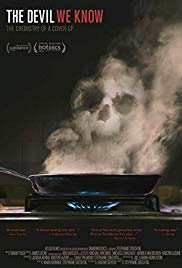Part 1 – The History Behind Nonstick Products
Over the summer, Christian and I watched a fantastic documentary on Netflix called “The Devil We Know” about a chemical compound used in the production of Teflon and DuPont’s role in covering up potential negative health impacts.[1] About a month ago, I saw a trailer for the movie “Dark Waters” and knew about 25 seconds in that this movie was about that exact subject.[2] With the release of “Dark Waters” in theaters this coming weekend, it seemed like a good time to dive into the details around the health concerns of Teflon.
The documentary “The Devil We Know” is incredibly comprehensive and provides the bulk of the information I am summarizing here, unless otherwise noted. I strongly recommend watching it if you can (probably before going to see the movie). The creators of the documentary spoke with residents of Parkersburg, West Virginia and the surrounding communities, former DuPont employees, attorneys (including Rob Bilott, who is the protagonist in “Dark Waters”), and journalists. They included footage of depositions given by DuPont executives, but could not get DuPont to participate in the documentary directly.

Image Credit: [3]
SPOILER ALERT?: I strongly recommend viewing the documentary if you have the ability to watch it, and I am very much looking forward to seeing the movie. This post probably contains enough information to spoil something in the movie, but all of the facts below are publicly-available information as it stands to date. I imagine the movie will contain some level of interpersonal/family drama between semi-fictional main characters, and I know nothing about that at this point.
What is Teflon and the chemicals that make it?
Let’s start off with a little background on the production of Teflon: its chemical name is polytetrafluoroethylene,[4] and it was created by accident in 1938. It has many qualities, including being non-stick, oil-repellant, and water-repellant. Teflon’s first major use was during World War II as part of the Manhattan Project, where it was used as a material for corrosion-resistant gaskets and seals.
The chemical compound under scrutiny as the health risk in both the documentary and the movie is not Teflon itself, but perfluorooctanoic acid, or PFOA, (also known as C8), a surfactant used in the manufacturing of Teflon.[5] Surfactants are used to reduce the surface tension of liquids, which helps increase the suspension of certain compounds within solutions. While surfactants themselves are not necessarily bad (as far as I know), they have come up in a variety of topics on this blog before and are used in applications such as wetting agents (in Roundup)[6] and detergents (in shampoos)[7].

Image credit: [8]
3M created PFOA in 1947, and DuPont purchased it from them for use in their manufacturing process. DuPont and 3M began studying impacts of the compound known as C8 in the 1950s and ‘60s. They intended to get a baseline sample of blood so they could compare the blood of factory workers against those never exposed to the compound. The problem was that there was no baseline blood available anywhere in the world. For reasons they could not explain, people all over the globe had been exposed at one point or another, most likely through material deteriorating over time and leaching into food from cookware, but also from water- and stain-resistant sprays on couches, carpets, and clothing. After extensive testing, the companies eventually determined that C8 was already in the blood of 99% of all Americans, and the only “baseline blood” available was in archived samples from soldiers who had fought in the Korean War, which was before mass-market availability of non-stick products.
Suspected Impacts from Exposure
Both the movie trailer and the documentary introduce the conflict through the story of Wilbur Tennant, a cattle farmer in Parkersburg, WV, whose property was downstream of the DuPont plant that produced the chemical compounds used in Teflon products. He observed fish dying in the stream that ran through his property; the fish were followed by deer that drank from the stream. His cattle showed symptoms of milky eyes (from birth), slobbering, and black or brown teeth. In 1997, after all 150-plus head of cattle died, he sued DuPont. DuPont settled with him out of court in 2001, but he died in 2009 of a heart attack, after also having been diagnosed with cancer.

The documentary also interviews former employees at DuPont, two of whom used to work directly with the chemical compound C8. The first, a woman, worked with C8 before the birth of her son, who had extensive birth defects. DuPont eventually removed women from any contact with C8 after rat studies showed deformities in rat fetuses after exposure to the chemical. The company held their position that there was no danger to the women; only to the fetuses. Men remained on the line, as DuPont insisted that there was no danger to them. The man interviewed in the documentary had a history of health problems of his own, was diagnosed with terminal cancer, and in his interview recited a long list of friends and coworkers who are now dead from various types of cancer.
The woman who was eventually taken off of C8 production talked about what she was asked to do when working with the chemical. She described how she was instructed to dump effluent from the manufacturing process directly into the river that flowed past the plant, despite the fact that 3M instructed DuPont not to do that. Residents from a town 40 miles downriver were interviewed for the documentary, and they have exhibited health conditions now known to be tied to C8 exposure, such as ulcerative colitis and thyroid dysfunction.
The warning level of C8 in water is one part per billion, the equivalent of one drop of the compound in an olympic-sized swimming pool. According to the documentary, the levels are significantly higher than that in the Ohio River valley. Communities up- and down-river from the Parkersburg plant have since identified these chemicals in their drinking water. However, DuPont claimed that there was no negative impact from exposure, and these communities are not in danger.
Next week we’ll take a deeper look at the corporate response related to health concerns around this chemical compound.
Thanks for reading!
[1] https://en.wikipedia.org/wiki/The_Devil_We_Know
[2] https://en.wikipedia.org/wiki/Dark_Waters_(2019_film)
[3] https://www.imdb.com/title/tt7689910/
[4] https://en.wikipedia.org/wiki/Polytetrafluoroethylene
[5] https://en.wikipedia.org/wiki/Perfluorooctanoic_acid
[6] https://radicalmoderate.online/roundup-and-glyphosate-part-1/
[7] https://radicalmoderate.online/how-often-do-you-really-have-to-wash-your-hair/
[8] https://www.imdb.com/title/tt9071322/?ref_=nv_sr_1?ref_=nv_sr_1
[9] https://www.treehugger.com/green-home/how-cook-non-stick-cookware-if-youre-stuck-it.html
2 Comments
Community Supported Agriculture, Part 5 – Selecting Food – Radical Moderate · January 3, 2021 at 11:02 am
[…] [15] https://radicalmoderate.online/the-devil-we-know-and-dark-waters-teflon-in-the-media-part-1/ […]
“My Cabin Doesn’t Leak When it Doesn’t Rain,” Part 3 – Radical Moderate · January 24, 2021 at 10:00 am
[…] [9] https://radicalmoderate.online/the-devil-we-know-and-dark-waters-teflon-in-the-media-part-1/ […]